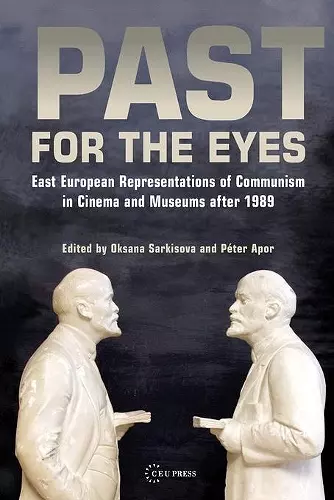Past for the Eyes
East European Representations of Communism in Cinema and Museums After 1989
Péter Apor editor Oksana Sarkisova editor
Format:Paperback
Publisher:Central European University Press
Published:1st Jan '08
Currently unavailable, and unfortunately no date known when it will be back

How do museums and cinema shape the image of the Communist past in today’s Central and Eastern Europe? This volume is the first systematic analysis of how visual techniques are used to understand and put into context the former regimes. After history “ended” in the Eastern Bloc in 1989, museums and other memorials mushroomed all over the region. These efforts tried both to explain the meaning of this lost history, as well as to shape public opinion on their society’s shared post-war heritage. Museums and films made political use of recollections of the recent past, and employed selected museum, memorial, and media tools and tactics to make its political intent historically credible. Thirteen essays from scholars around the region take a fresh look at the subject as they address the strategies of fashioning popular perceptions of the recent past.
"With their collection of essays, Oksana Sarkisova and Péter Apor aim at an interim statement about this multifaceted wave of remembrance by focusing on visual material, namely cinema and museums. Their geographical scope is broad - from the Baltic region to east central Europe and the Balkans, including Russia. They have organized the thirteen contributions in three parts "so as to reflect upon the concepts of 'document,' 'nostalgia' and 'objects,' which are crucial, but underexplored aspects of the complicated relationships between professional historical work and other spcial practices of evoking the past." Past for the Eyes is a major contribution to the booming field of studies exploring how communism is remembered in postcommunist societies." * Slavic Review *
"Books on the CEE transformations that deal with media and popular cultures should be welcomed. Past for the Eyes belongs to this extraordinary breed. The book is devoted to the visual representations of the socialist / communist past and the forms they took. The interconnected processes of visualization of the past, and the collective memory sedimentation are the main focus. The book brings together perspectives of linked but still distinctive ways of enquiry: visual studies, cultural studies, area studies, museum studies and contemporary history with its passion for ethnography and oral evidence. One of the common threads which stitch the chapters together and turn the collection into a quite homogenous regional report on an updated 'structure of feeling', are the authors' horizons referring to the experience of being post-socialist in a postmodern condition. They help to sense that there is something peculiar about reconsidering, revisiting and even rejecting a politically evil regime from the perspective that does not allow for any clear discrimination between what is ultimately good and evil. Simultaneity seems to be an important strategy for both researchers and filmmakers as objects of their enquiry. In many cases chapters recall visual texts which deplore the socialist regime while they simultaneously remain aware of the limits of any orthodoxy. This attitude of alertness and reflexivity is far removed from any 'so-we-will-be-free-now' optimism, and the collapse of this particular ideology is combined with the awareness that 'ideology is not a historically specific bad thing', as John Corner put it elsewhere." * Politics and Culture *
"Intellectually engaging and timely, Past for the Eyes inquires into how socialism is shown and seen in the cinema and museums of contemporary Eastern Europe. This collection of fourteen fine essays joins an exciting (and rapidly intensifying) debate in the social sciences and humanities concerned with the memory's many manifestations in today's world. The volume demonstrates that the former communist Bloc offers an especially productive setting in which to examine practices of social remembrance, especially those that pertain to the memorialization of the recent Marxist-Leninist past. Threading through the volume are questions concerning the uneasy relationship between popular visual representations and professionally produced historiographic texts as means for recuperating socialism. The contributors ask whether imagery on the screen and objects displayed in museum spaces have as much authority in representing the era of Party rule as the written, 'institutionalized' word. Can word and image as agents of the past coexist in a complementary dialectic? Who is more 'reliable' as producer of historical knowledge - the historian or the artist? Past for the Eyes is an intelligent and welcome addition to the study of socialist memory (and any other memory, for that matter) through film and museum displays. Richly illustrated and smartly argued, the essays comprising this groundbreaking volume should be read by scholars and students interested in East European socialism as an 'unforgettable' past that persists in the present." * Journal of Baltic Studies *
ISBN: 9789639776050
Dimensions: unknown
Weight: unknown
436 pages